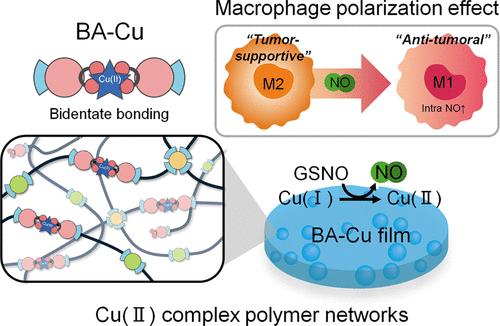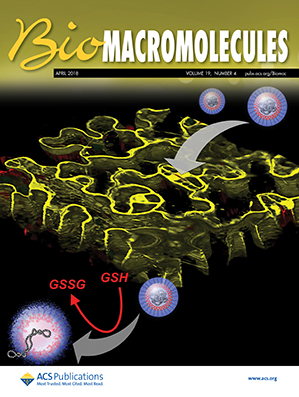在肿瘤治疗中持续释放一氧化氮的铜(II)有机配位聚合物网络
IF 5.4
2区 化学
Q1 BIOCHEMISTRY & MOLECULAR BIOLOGY
引用次数: 0
摘要
一氧化氮(NO)能使巨噬细胞极化为促炎 M1 表型,从而在调节免疫系统方面发挥关键作用,这有利于癌症免疫疗法。我们开发了一种铜-有机配位聚合物网络,可从内源性供体中持续释放一氧化氮。这种坚固的聚合物网络是通过络合和交联双重作用过程构建而成的。去质子化的 4-((6-(丙烯酰氧基)己基)氧基)苯甲酸(BA)的羧酸基团可作为形成 Cu(II) 复合物的双齿配体。BA 的丙烯酸酯分子将这些络合物固定在聚合物网络中,形成交联薄膜。网络中的铜离子催化促进了 S-亚硝基谷胱甘肽中 NO 的释放,即使在生理环境中 90 天后仍能保持这种释放。释放的 NO 能有效地将静息(M0)和肿瘤促进(M2)巨噬细胞极化为 M1 表型。BA-Cu 薄膜具有生理稳定性和持续释放 NO 的性能,有望成为能够持续促进抗肿瘤巨噬细胞的抗癌贴片。本文章由计算机程序翻译,如有差异,请以英文原文为准。

Cu(II)-Organic Coordination Polymer Networks for Persistent Nitric Oxide Release in Tumor Therapy
Nitric oxide (NO) plays a key role in regulating the immune system by polarizing macrophages toward the proinflammatory M1 phenotype, which is beneficial for cancer immunotherapy. We developed a Cu-organic coordination polymer network to sustainably release NO from endogenous donors. This robust polymer network was constructed through a dual-interaction process: complexation and cross-linking. The carboxylate groups of deprotonated 4-((6-(acryloyloxy)hexyl)oxy)benzoic acid (BA) served as bidentate ligands for the formation of Cu(II) complexes. The acrylate moiety of BA anchored these complexes in the polymer network, forming a cross-linked film. Cu ions within the network catalytically promoted NO release from S-nitrosoglutathione, maintaining this release even after 90 days in a physiological environment. The released NO effectively polarized both resting (M0) and tumor-promoting (M2) macrophages to the M1 phenotype. With their demonstrated physiological stability and sustained NO release performance, BA-Cu films hold potential as anticancer patches capable of continuously promoting antitumoral macrophages.
求助全文
通过发布文献求助,成功后即可免费获取论文全文。
去求助
来源期刊

Biomacromolecules
化学-高分子科学
CiteScore
10.60
自引率
4.80%
发文量
417
审稿时长
1.6 months
期刊介绍:
Biomacromolecules is a leading forum for the dissemination of cutting-edge research at the interface of polymer science and biology. Submissions to Biomacromolecules should contain strong elements of innovation in terms of macromolecular design, synthesis and characterization, or in the application of polymer materials to biology and medicine.
Topics covered by Biomacromolecules include, but are not exclusively limited to: sustainable polymers, polymers based on natural and renewable resources, degradable polymers, polymer conjugates, polymeric drugs, polymers in biocatalysis, biomacromolecular assembly, biomimetic polymers, polymer-biomineral hybrids, biomimetic-polymer processing, polymer recycling, bioactive polymer surfaces, original polymer design for biomedical applications such as immunotherapy, drug delivery, gene delivery, antimicrobial applications, diagnostic imaging and biosensing, polymers in tissue engineering and regenerative medicine, polymeric scaffolds and hydrogels for cell culture and delivery.
 求助内容:
求助内容: 应助结果提醒方式:
应助结果提醒方式:


